Chalk hyssop: cultivation, application and properties
From biblical times, a representative of the Yasnotkov family, chalk hyssop, has been famous among spicy herbs. This plant not only has a specific aroma, but can also become a garden decoration. And its beneficial properties are used in folk medicine. Therefore, it is worth growing hyssop in a summer cottage in order to appreciate the benefits and beauty of herbaceous culture.
The chalk hyssop is not without reason listed in the Red Book, because the plant is rarely found in the wild. Its population suffers from the development of chalk quarries, as a result of the construction of roads. It is eaten on pastures in huge quantities by sheep and goats. But to get acquainted with the useful properties of the plant, you can grow hyssop on the site. It is unpretentious in maintenance and will become a decoration of the landscape.
Content:
- Description of the species and conditions for its cultivation
- Reproduction and care tips
- Properties, application in medicine, cooking
- Use in landscape design
Description of the species and conditions for its cultivation
Due to the narrow ecological confinement of Cretaceous hyssop, it is found only on the Cretaceous outcrops of the Central Russian plains. He settles on cliffs, slopes, consisting of a loose chalk substrate. The plant is cultivated in botanical gardens, it is also bred in summer cottages.
- A perennial from twenty to fifty centimeters in height has many pubescent cylindrical stems.
- Shoots move away from the root, and their number increases from year to year.
- The narrow leaves of the plant with flat edges are covered with hairs. From June to August, the grass is covered with blue, less often white flowers.
- Their corollas are pubescent and collected in compressed inflorescences. In the fall, in place of flowering spikelets, a triangular brown nut containing seeds remains.
The plant attracts bees with its aroma. For leaves and flowers, there is a use in cooking, medicine. But the popularity of the chalk hyssop is still small, it is not appreciated by gardeners. Hyssop chalk prefers light, loose soil. Grass grows best in open sunny places, but partial shade will be glad too. She is not afraid of the scorching rays of the sun, it is resistant to drought.
Soils for chalky hyssop are best selected with calcareous.
The grass feels uncomfortable in wetlands. Before the spring planting of a perennial, the plot is dug up, bringing in up to five kilograms of humus per square meter. The soil should contain both potassium salt and superphosphate (twenty grams per square meter). In the spring, before planting, you need to dig up the area, adding fertilizers - urea or ammonium nitrate. A complex fertilizer such as Kemira.
For the winter, the hyssop can be left uncovered. It can withstand low temperatures, very rarely freezes due to getting wet, if planted in low areas. In one place, the grass can grow from four to six years. Then the plantings begin to shrink. Therefore, plant propagation is carried out by transferring hyssop to another site.
Reproduction and care tips
Chalk hyssop is propagated in several ways:
- Plant seeds are placed to a depth of one centimeter in early spring. A distance of at least fifty centimeters is left between the rows. Seedlings are obtained a week or two after sowing.
- Seedlings are planted in April, then diving in the phase of two or three leaves. Before planting in open ground, the seedlings should live 45 days. And by the fall, the plants will be strong and hardy.
- The vegetative propagation method involves dividing a three-year-old bush into parts. Each is planted separately, well buried in the ground. To strengthen the root and stimulate the development of adventitious processes, the bushes spud. The breeding procedure can be carried out during the summer.
- By cuttings are engaged in spring, cutting off branches ten centimeters long from the shoots. For rooting, cuttings are planted in a sandy substrate, choosing a shaded area. Only after the roots appear, the chalky hyssop is transplanted to a permanent place.
Grass planting is easy to care for. It consists of weeding and loosening the soil as needed. The bushes are watered only in very dry periods. But without top dressing, the hyssop will bloom poorly. Therefore, in the spring, add ammonium nitrate, superphosphate, potassium salt. Fertilizers are taken per square meter in the range of 10-20 grams.
Mowing hyssop bushes annually will help shape the crown of the perennial and decorate the area with it.
Preventive pruning is also carried out in the spring, removing damaged, weak shoots after winter. Grass is cut two or three times per season. The cut stems are laid out in the shade under a canopy and dried. For storage, dried hyssop is placed in an airtight container.
To obtain plant seeds, cutting is carried out from the second year of the grass's life. As soon as the seeds start to turn brown, they will crumble. If you do not harvest the seeds, then they will scatter over the site, germinating randomly.
Properties, application in medicine, cooking
Blanks of dried herb of chalky hyssop contain essential oils that have a strong odor similar to camphor and turpentine. In addition, the herb contains glycosides, tannins, and resins. Of the vitamins in one hundred grams of hyssop - more than fifty milligrams of ascorbic acid, eight - carotene.
What properties does the plant have:
- The bactericidal properties of the plant are known. Infusions and decoctions of leaves and flowers soothe, stimulate the intestines. They gargle with sore throat, wash the eyes with inflammation of the conjunctiva.
- Herbal compresses help relieve the symptoms of joint inflammation, heal wounds, ulcers, and eliminate swelling.
- Tincture of hyssop cures chronic colitis, expels worms. To whet the appetite, relieve the symptoms of inflammation in the stomach, intestines, prepare a drink from two teaspoons of grass per 250 milliliters of cold water, bringing to a boil.
The spice is contraindicated for pregnant women, as it will cause premature birth or miscarriage. And for people with disorders of the nervous system, even inhalation of hyssop vapors will be harmful.
In cooking, spicy herbs are added to meat, fish and vegetable dishes.
The aroma of hyssop goes especially well with legumes. The herb is suitable for flavoring sausages, mayonnaise, curd desserts. It can be mixed with parsley and celery... Spice drinks attract with their original aroma and taste. Due to the presence of essential oils in hyssop, it is used for the manufacture of perfumery and liqueurs.
To enjoy the beneficial properties of chalky hyssop, its aroma, you need to grow grass on the site. The smell will attract bees, and the herb-based honey is delicious. Therefore, the plant is sown near the apiaries. Thanks to the planting of perennials, they solve the problem of pollination of garden plants. After hyssop, other crops can be planted, since the soils in the places where it grows become nutritious, loose.
Use in landscape design
Lushly overgrown chalk hyssop bushes will become a true decoration of the garden:
- If you carry out a haircut, giving them an original shape, then you can select a section of grass in rockeries, on the alpine slides.
- Planting hyssop on the slopes, cliffs near an artificial reservoir looks interesting.
- Islets of blue flowers will decorate the green carpet of the lawn.
- Tall bushes of flowering hyssop are used to create the boundaries of the site, dividing it into zones.
- Blue inflorescences go well with other cultivated plants - delphinium and hydrangea.
The use of grass in the garden will allow you to vary the styles of the garden, giving the landscape a natural look.
More information can be found in the video:



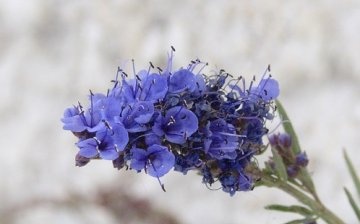
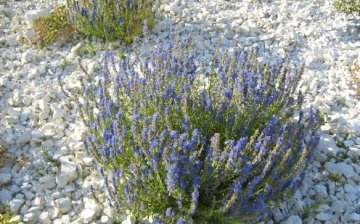
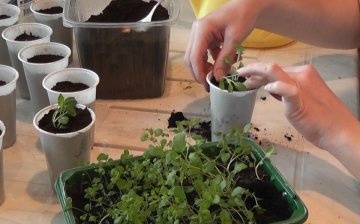

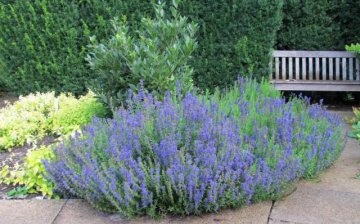






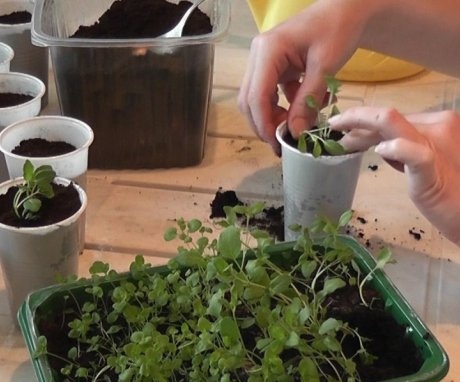


I do not think that this plant is so rare, in the next house it completely occupies a concrete flower bed and outside the city I also saw him Hyssop more than once. I did not know that this plant has so many useful properties and that it is suitable for spicy seasoning, meat and fish dishes.
Great plant. Be sure to plant it in your garden, you can in a flower bed. We use this herb as an amazing seasoning for meat dishes. Can also be added to soups. Recommended!
As I understand it, the herb is very useful in folk medicine, it somehow reminded me of one type of grass, which is considered a weed. Can this grass grow on its own in the field, or was I mistaken?